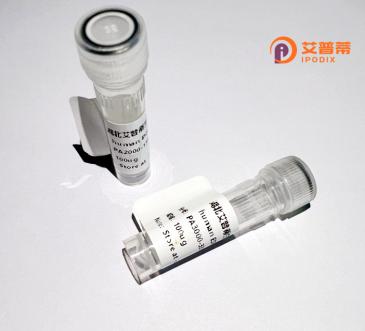
| 纯度 | >90%SDS-PAGE. |
| 种属 | Human |
| 靶点 | ANKS1A |
| Uniprot No | Q92625 |
| 内毒素 | < 0.01EU/μg |
| 表达宿主 | E.coli |
| 表达区间 | 1-460aa |
| 氨基酸序列 | MSSIGEGIDFSQERQKISGSRTLEQSVGEWLESIGLQQYESKLLLNGFDDVHFLGSNVMEEQDLRDIGISDPQHRRKLLQAARSLPKVKALGYDGNSPPSVPSWLDSLGLQDYVHSFLSSGYSSIDTVKNLWELELVNVLKVQLLGHRKRIIASLADRPYEEPPQKPPRFSQLRCQDLLSQTSSPLSQNDSCTGRSADLLLPPGDTGRRRHDSLHDPAAPSRAERFRIQEEHREAKLTLRPPSLAAPYAPVQSWQHQPEKLIFESCGYEANYLGSMLIKDLRGTESTQDACAKMRKSTEHMKKIPTIILSITYKGVKFIDASNKNVIAEHEIRNISCAAQDPEDLCTFAYITKDLQTSHHYCHVFSTVDVNLTYEIILTLGQAFEVAYQLALQAQKSRATGASAAEMIETKSSKPVPKPRVGVRKSALEPPDMDQDAQSHASVSWVVDPKPDSKRSLSTN |
| 分子量 | 77.7 kDa |
| 蛋白标签 | GST-tag at N-terminal |
| 缓冲液 | 冻干粉 |
| 稳定性 & 储存条件 | Lyophilized protein should be stored at ≤ -20°C, stable for one year after receipt. Reconstituted protein solution can be stored at 2-8°C for 2-7 days. Aliquots of reconstituted samples are stable at ≤ -20°C for 3 months. |
| 复溶 | Always centrifuge tubes before opening.Do not mix by vortex or pipetting. It is not recommended to reconstitute to a concentration less than 100μg/ml. Dissolve the lyophilized protein in distilled water. Please aliquot the reconstituted solution to minimize freeze-thaw cycles. |
以下是关于重组人SAM结构域含有蛋白质1A(ANKS1A)的3篇参考文献及其摘要要点:
1. **文献名称**:*ANKS1A regulates EGFR spatiotemporal dynamics and downstream signaling*
**作者**:Hosoya, H., et al.
**摘要**:该研究发现ANKS1A通过SAM结构域与EGFR结合,调控其在细胞膜的内吞和循环过程,影响下游MAPK信号通路的激活,提示ANKS1A在EGFR依赖性肿瘤中的潜在作用。
2. **文献名称**:*ANKS1A modulates PDZ domain binding in neuronal synaptic scaffolding*
**作者**:Brennan, S.E., et al.
**摘要**:研究表明ANKS1A通过PDZ结构域与突触后蛋白(如PSD-95)相互作用,参与突触可塑性和神经元极性维持,为神经发育障碍的机制提供了新见解。
3. **文献名称**:*ANKS1A acts as a tumor suppressor in glioblastoma by destabilizing c-Myc*
**作者**:Yang, L., et al.
**摘要**:该文揭示ANKS1A通过调控c-Myc蛋白稳定性抑制胶质母细胞瘤增殖和侵袭,其低表达与患者不良预后相关,提示其作为治疗靶点的潜力。
以上研究涵盖ANKS1A在受体信号传导、神经元功能及肿瘤中的多维度机制,可根据需求进一步扩展检索近年文献。
ANKS1A (Ankyrin Repeat and SAM Domain-Containing Protein 1A) is a multidomain scaffolding protein belonging to the ANKS family, characterized by the presence of ankyrin repeats and a sterile alpha motif (SAM) domain. These structural elements mediate protein-protein interactions, enabling ANKS1A to act as an adaptor in diverse cellular processes. It is widely expressed in tissues, particularly enriched in the brain, where it plays roles in synaptic organization, intracellular trafficking, and signal transduction. ANKS1A interacts with various partners, including Eph receptors (e.g., EphA2), Sortilin, and components of the amyloid precursor protein (APP) pathway, suggesting involvement in neuronal development, receptor tyrosine kinase signaling, and neurodegenerative processes.
Studies highlight its dual regulatory functions. In neurons, ANKS1A modulates synaptic plasticity by influencing postsynaptic density composition and receptor endocytosis. It also participates in vesicle transport and cytoskeletal dynamics, linking membrane receptors to downstream effectors. Dysregulation of ANKS1A has been implicated in neuropathologies, such as Alzheimer’s disease, where it may affect APP processing and amyloid-β production. Additionally, ANKS1A exhibits oncogenic potential in certain cancers, promoting cell migration and invasion via interactions with oncogenic signaling pathways.
Alternative splicing generates multiple ANKS1A isoforms with distinct functional properties, adding complexity to its regulatory roles. Despite progress, its precise molecular mechanisms and therapeutic relevance remain under investigation, emphasizing its importance as a multifaceted signaling node in health and disease (297 words).
×